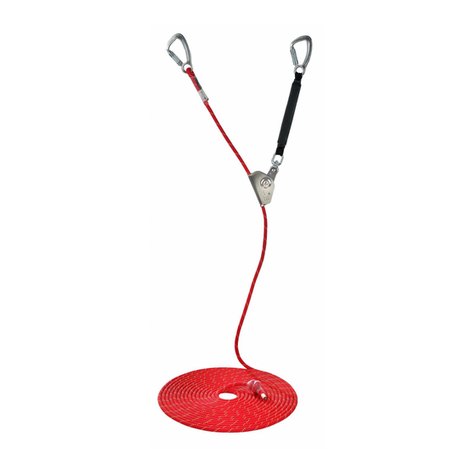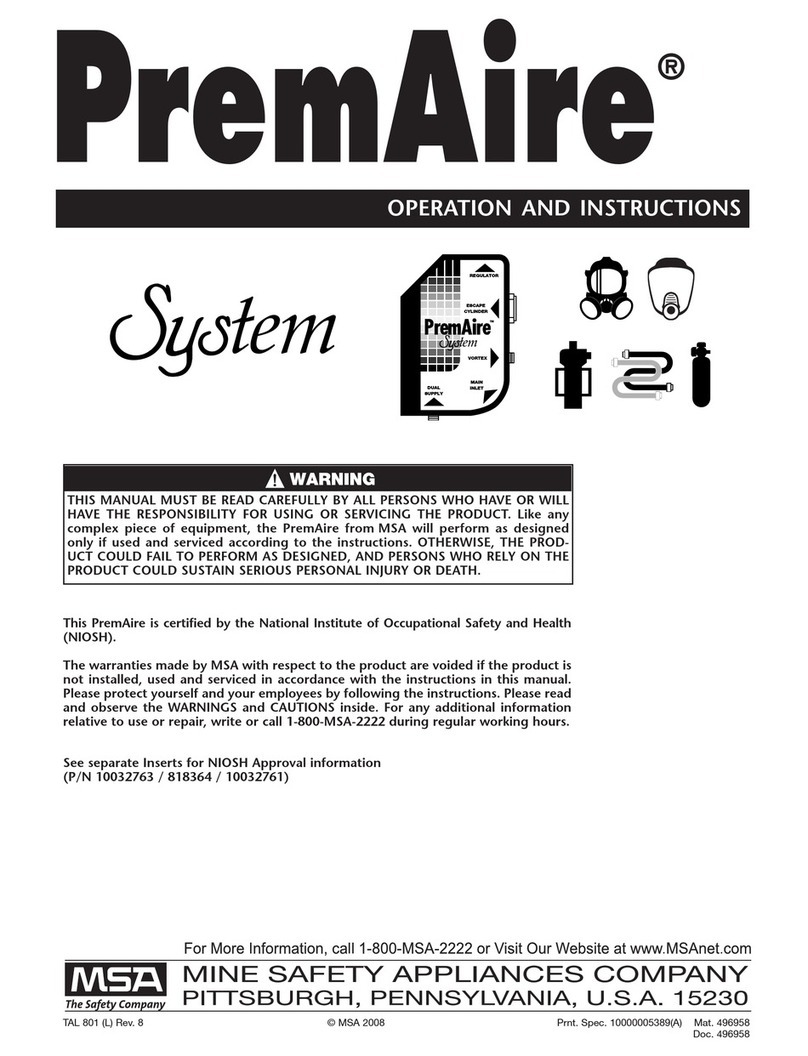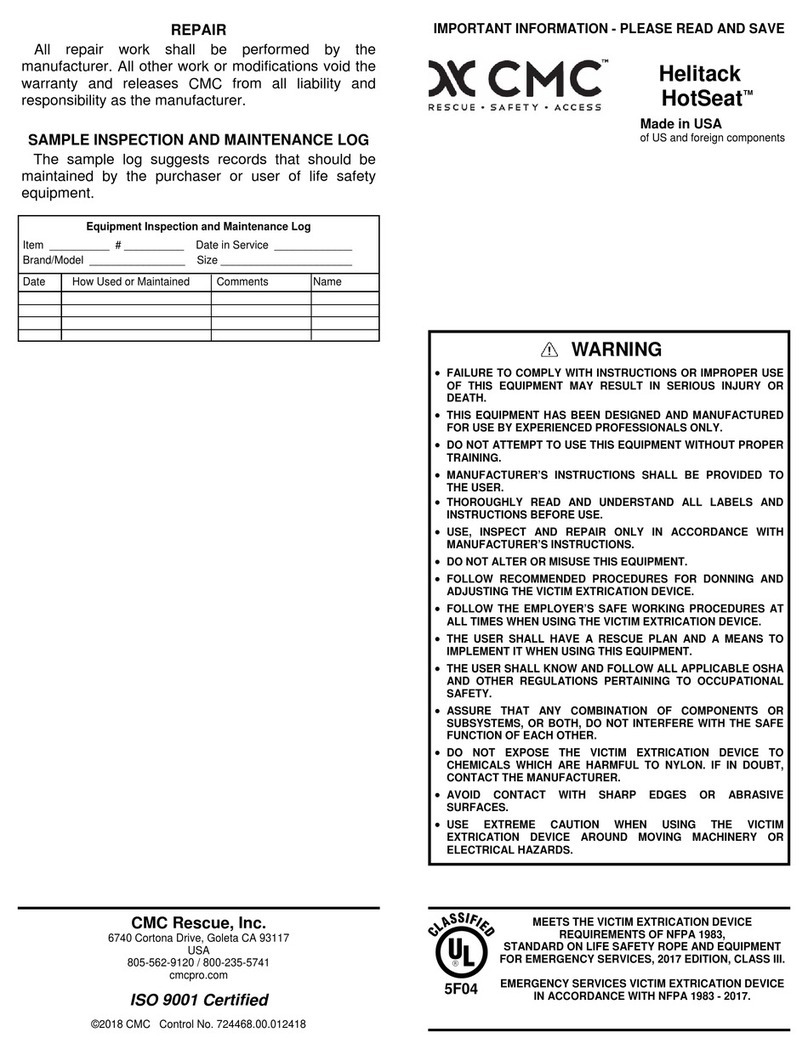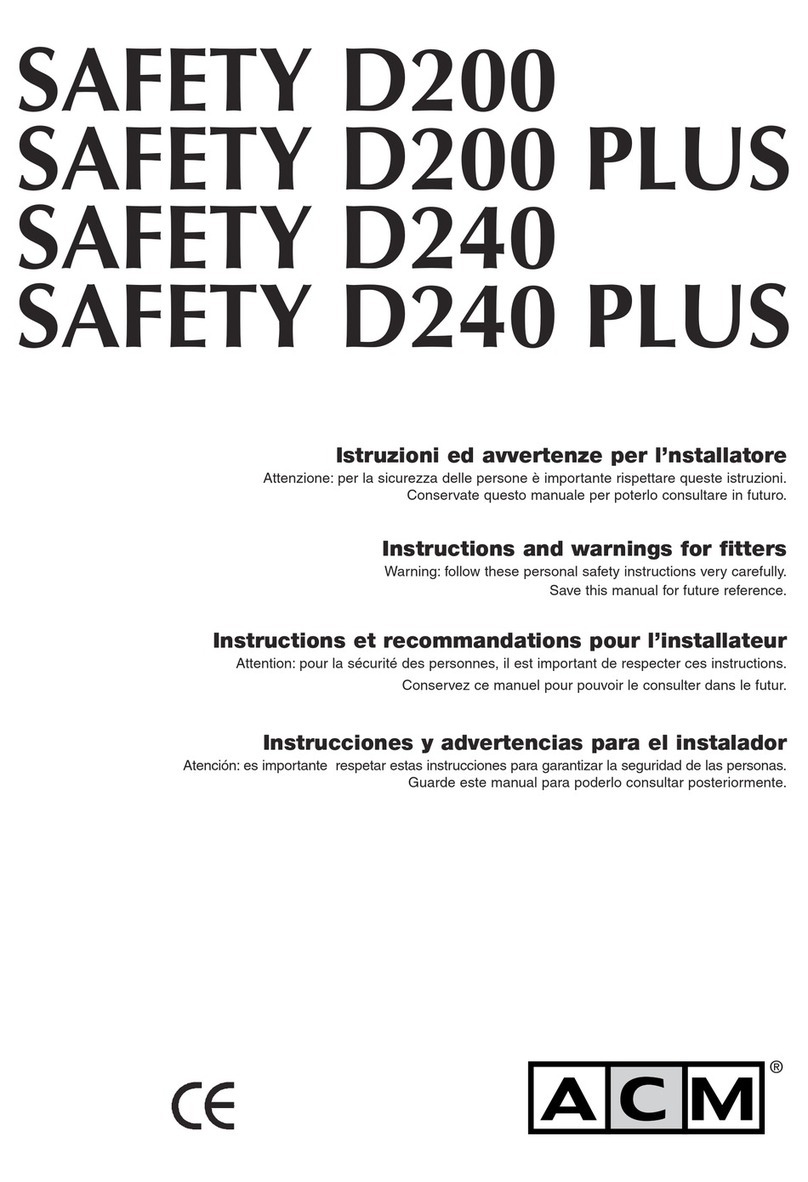Eyolf MBS 19kN User manual

Tak
8mm Prusik Loop
MBS 19kN
B50-45 - Tak 45 cm / 18” - 8mm Sewn Prusik Loop
B50-60 - Tak 60 cm / 24” - 8mm Sewn Prusik Loop
B50-45 - Tak 75 cm / 30” - 8mm Sewn Prusik Loop
8mm Prusik Loop

Intended use
The product has been tested for specic use, do not use the
product other than indicated without the consent of the manu-
facturer.
PPE
PPE stands for Personal Protective Equipment and in case of this
product this means it should be provided to an individual user.
Strengths
Strengths quoted are when the product is tested new and are
in accordance with the manufacturers test methods or to the
appropriate standard. Any weights and measurements are
approximate.
Compatibility
Make sure that each item in an assembly can be used together
and work as a system. Compatibility needs to be checked prior
to use. Check individual manuals for each item and see if they
can be used together.
Safe use
When working at height or other related activities such as rope
access: never rely on a single piece of equipment always make
sure you have an equal redundant back-up system.
Multiple Loading
Do not subject the hook to multiple forces, which could cause
hook body deection resulting in gate failure.
Adding a connector to the stitched loop.
Do not clip in an extra connector, as the stitching won’t hold!
Sharp edges should be avoided at all times. If it cannot be avoid-
ed proper precautions should be taken.
Do not fall into the slings directly without any energy absor-
bance.
Minimize a fall at all times, check your fall factors and the equip-
ment your using to see if it can survive the impact. See drawing
on fall factors.
Use in extreme environment
Use of any PPE in extreme environments can be dangerous. It is
important to do appropriate testing before the use of our prod-
ucts in environments such as extreme cold or high tempera-
tures (working temperatures are -30 degrees up to 60 degree
Celsius), chemicals, dust, sand and other foreign materials,
electrical power, grinding and chang should be avoided, if you
have any questions contact us and we can help you determine
the eects.
Inspection
An examination should be carried out before the product is put
into service.
Periodic examinations should takes place at least once a year,
taking into account factors such as legislation, equipment type,
frequency of use, and environmental conditions.
A periodic exam should be carried out by a competent person.
For complex items such as self retractable lifelines please con-
tact us for further details.
Before each use visually inspect to ensure the product is in ser-
viceable condition and operates correctly. If any compromises
are found do not use the product and retire it.
If the product has been used to arrest a fall, withdrawn from
use immediately! Do not use again until, in writing, a competent
person says it is acceptable for use.
A pre-use check by the user may not be applicable if the user
is under supervision of a competent person or in the case it is
used for emergency use which have been pre-packed or sealed
by a competent person.
When carrying out an inspection pay attention to the following
items:
Check the label / marking (visible, legible, age)
Check webbing (cuts, burns, wear, chemical marks, crushed,
other damage)
Check stitching (cut, worn, coloured or disordered threads)
Check attachment points (deformation, cracks, wear, corrosion,
marks)
Check O-ring and connectors (deformation, cracks, wear, corro-
sion, marks)
Check compatibility of connector
Check condition of protective components
Maintenance
Always keep the product clean and dry. Any excess moisture
should be removed with a clean, dry cloth and then allowed to
dry naturally in a warm room away from direct heat.
Rinse in clean cold water. If still soiled wash in clean warm water
(max. 40°C) with a soft detergent (within pH range of 5.5 to 8.5).
You can use a front loading washing machine but rst place the
product in a washing bag to protect against mechanical damage.
Rinse properly in clean cold water and if needed to disinfect use
a solution of water with alcohol. Do not use bleach!
ollow these instructions, if in doubt about the disinfecting meth-
od please contact us for further details.
Lubrication
When lubrication is needed a silicon or Teon based spray can
be used. Do not excessively spray the lubricant over the buckle
or gate. Wipe o any excess and protect any webbing or rope
from being sprayed.
Storage - Transportation
After cleaning, store unpacked in a cool, dry, and dark place
away from direct sunlight, as UV will cause damage to the web-
bing over time, excessive heat sources, sharp edges, vibration or
other possible causes of damage. Do not store when wet or in a
damp area >70%. If a long shelf life is required it is advisable to
store in a moisture proof package, like a polyethylene bag.
EN
Personal protective equipment against falls from a height.
General requirements for instructions for use, maintenance,
periodic examination, repair, marking and packaging as per EN
365:2004
Thank you for using an Eyolf product. We have done everything
possible to ensure that the information provided in this manual
is accurate at the time of publication. However, we do not
guarantee that this information will remain up to date, as many
products and techniques change over time.
Mountaineering, climbing, caving, working at height and other
related activities are inherent dangerous due to outside factors
and hidden risks. Not understanding, taking precautions and
eliminating these risks can lead to serious injuries and death.
If in doubt do not use the product!
Contact us if you have any questions or concerns.
Warning
Medical condition
It should be understood that working at height and the use
of equipment to do so, involves a certain amount of physical
and mental exertion. Certain medical conditions are a denite
contra-indication to the safe use of the equipment and working
at height.
Training
Training and assessment of competency are essential before
use of this product.
Users must be aware of the limitations, precautions and the
dangers of misuse.
Risk assessment - rescue plan
A risk evaluation and a quick response rescue plan should be in
place prior to any activities at height.
For instance that, if the risk assessment carried out before the
start of work shows that loading in the case of a use over an
edge is possible, appropriate precautions should be taken.
Also to deal with any emergencies that could arise during the
work/exercise. Relying upon a local emergency rescue team is
not a rescue plan and could get you in severe trouble as they
might not be capable or take too long to perform a rescue.
Have a suitable rescue plan in place!
Repairs
Do not make any alternations or additions to the product with-
out the manufacturer’s prior written consent. Repairs shall only
be carried out in accordance with manufacturer’s procedures.
Without consent any repair or alterations should be done by the
manufacturer.

Lifespan
This is dicult to estimate but we advise as follows: Do not use
more than ten years after the date of manufacture. Assuming
you have used the correct storage, the working life can vary
from a ten year span to a single use in extreme circumstances
(e.g. highly chemical environment, serious fall, etc.). UV light
including sunlight will reduce the working life.
Anchoring
Any fall arrest anchorage used should be able to withstand a
force of 22kN when not certied or withstand at least two times
the Maximum Arrest Force when engineered.
Do not create slack in the system and avoid any pendulum
eect / swing during a fall.
Ideally the user should be attached to the anchor as vertically as
possible.
For work positioning, restraint and rescue we advise the anchor
at least hold 12kN of force for every person/device attached to
it. (Load sharing is an option)
When connecting to an anchor device or structure use a suitable
form of connector complying with EN 362, either with a shock
absorbers, complying with EN 355, a lanyard, complying with EN
354 or sling and carabiners depending on the situation you are
in. Follow the standard EN 795 for anchoring.
Harness Connection Point
Connect the lanyard to the harness preferably to the sternal
attachment point. When not possible attaching to the ventral
attachment point is allowed as long as falls are impossible or
there is a proper energy absorbance in the system, such as a
dynamic rope system.
For fall arrest equipment, such as adding an energy absorber to
the lanyard the right connection point is the Sternal or Dorsal
attachment point, indicated with the letter A on a full body har-
ness complying with EN 361. This full body harness is the only
type of harness suitable for being used in a fall arrest system.
Fall clearance
It is important to keep in mind that the ight path is clear from
any obstacles when using a fall arresting system. It is essential
for safety to verify the free space required beneath the user at
the workplace before each occasion of use, so that, in the case
of a fall, there will be no collision with the ground.
Calculating the total fall clearance
The fall clearance is the distance required to safely arrest a fall.
It is the distance from the anchor to the ground.
Step 1 – calculate the Free Fall (F)
Step 2 – determine from the label how much the shock absorber
deploys (D)
Step 3 – determine the stretch of the harness (H)
Step 4 - add a safety factor of 2m (S)
Step 5 - add all gures together to get the clearance (C)
C=F+D+H+S
Fall Factor
A fall factor is an expression of the seriousness / severity of a
fall.
The fall factor is calculated based on how much distance can be
fallen, divided by the length of rope or lanyard used in a system.
A fall factor 2 is dangerous and could be lethal!
Falling
It should be clear that falling should be avoided at all times.
Where fall arrest systems are to be used, make sure you un-
derstand the system so that the work carried out is done in a
way to minimize any potential fall. Keep anchor points above
the user, use only a full body harness with a dorsal D-ring as an
attachment, and make sure you have a fall clearance.
It is also important to avoid any pendulum eect during a fall as
a sideward fall is unpredictable.
With our Y-lanyard it is advised to minimize the amount of slack
near a fall hazard.
When adjusting the length of a lanyard to avoid the risk of fall,
the user should not move into an area where there is a fall
hazard.
OUR ADVICE: DO NOT FALL!
Markings and/or symbols
On our label you will nd:
Product name, Product number (example B20) and assembly:
I = single lanyard or Y = Y style lanyard
E6 stands for 6kN Maximum Arrest Force
4 or 6 for length of lanyard
SH for snap hook and H for tower hook
DOM (date of Manufacture) in year and month
Serial # - Individual serial # or batch #
CE mark, which stands for “Conformité Européenne” (“European
Conformity”).
EN 355 is the European standard to which the product is certi-
ed.
Country of destination
It is essential for the safety of the user that if the product is
re-sold outside the original country of destination the reseller
shall provide instruction for use, for maintenance, for periodic
examination and for repair in the language of the country in
which the product is to be used.
Product specic
Prusik Loop
The Tak Prusik loop is specically designed to tie o a Prusik
knots onto another rope.
Make sure you understand the Prusik knots before using them.
Test the knot on the rope you are going to use it and keep an
eye out for environmental impact as condistions of the ropes
will change the behaviour of the knot.
1
2
3
4
5 - 3 Wrap Prusik knot

Supervision
Under certain circumstances where a person is temporarily
using a PPE against falling a competent and/or trained person
could supervise the user.
Read the manual and keep it
Keep the user instructions/information accessible as a perma-
nent record on- and o-site. Keep a copy of the manual with the
product at all times.
Warranty
Equipment oered by Eyolf Inc. are warranted against factory
defects in workmanship and materials for a period of three
years from date of installation or use by the owner, provided
that this period shall not exceed three years from the date of
manufacturing (see label on product). Upon notice in writing,
Eyolf Inc. will promptly repair or replace all defective items.
Eyolf Inc. reserves the right to elect to have any defective item
returned to its plant for inspection before making a repair or
replacement. This warranty does not cover equipment
damages resulting from abuse, damage in transit, or other
damage beyond the control of Eyolf Inc. This warranty applies
only to the original purchaser and is only one of applicable to
Eyolf products, and is lieu of all other warranties, expressed or
implied.
Eyolf Inc.
191 Gregson Court
Fergus ON
N1M 2W8 CANADA
Tel: +1 519 787 1581
Email: info@eyolf.ca
Web: www.eyolf.ca
Document: B50 Tak Prusik Loop rev1
PPE Inspection form
How to inspect your ropes.
Doc: Inspection form - Ropes Rev: 9 - Date: 2017-10
Copyright 2017 - Eyolf Inc
If there is any doubt or failure, the harness
should not be used.
Visual check of the safety components:
Readable labels present?
(Age of rope)
Check rope
(cuts, burns, wear, chemical marks, dents, coils, kinks, etc.)
Check stitching
(cut, worn, coloured or disorderd threads)
Check compatibility of connector
Check condition of protective components
(textile cover, pvc cover, thimble, etc.)
Operational check
Check hardware is in the right position
Check length with length on label
Check rotation and movement of moving parts
(must run freely)
Owner: Style of rope:
In Service:
Serial #:
Date of first use:Date of inspection:
Yes No
Comments:
Check sewn end-termination
(overloaded, wear, cuts, other damages)
Check knot (knot correct with application)
Check friction components (wear patterns)

INSPECTION
RECORD
Owner:
Address:
Product:
Model:
Serial #:
DoM:
First use:
Reason for entry inspection
or repair
Defects noted, repairs carried
out and other information
YEAR 1
INSPECTION RECORD
DATE:
RESULT:
INSPECTOR SIGNATURE:
YEAR 2
INSPECTION RECORD
DATE:
RESULT:
YEAR 3
INSPECTION RECORD
YEAR 4
INSPECTION RECORD
DATE:
RESULT:
INSPECTOR SIGNATURE:
YEAR 5
INSPECTION RECORD
DATE:
RESULT:
YEAR 6
INSPECTION RECORD
YEAR 7
INSPECTION RECORD
DATE:
RESULT:
INSPECTOR SIGNATURE:
YEAR 8
INSPECTION RECORD
DATE:
RESULT:
YEAR 9
INSPECTION RECORD
DATE:
RESULT:
INSPECTOR SIGNATURE:
YEAR 10
INSPECTION RECORD
DATE:
RESULT:
INSPECTOR SIGNATURE: INSPECTOR SIGNATURE: INSPECTOR SIGNATURE: INSPECTOR SIGNATURE:
INSPECTOR SIGNATURE: INSPECTOR SIGNATURE:
DATE: DATE:
RESULT: RESULT:
Table of contents
Other Eyolf Safety Equipment manuals
Popular Safety Equipment manuals by other brands
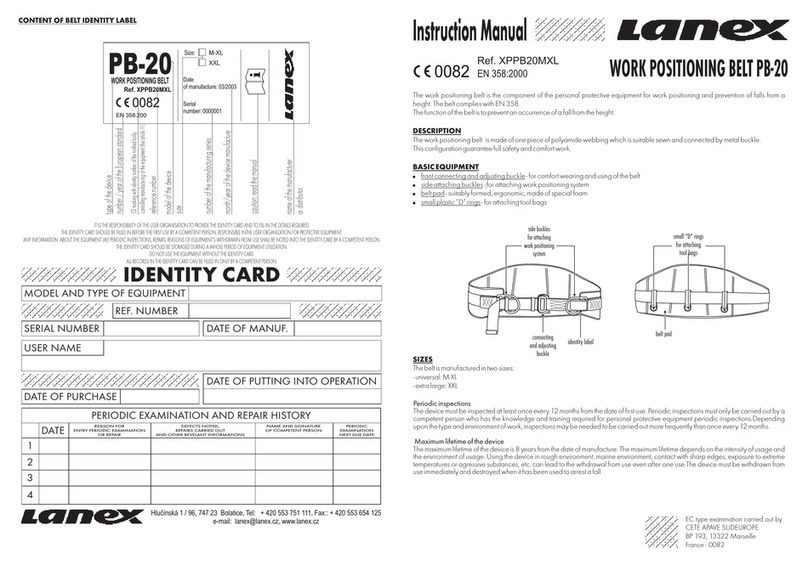
Lanex
Lanex PB-20 instruction manual
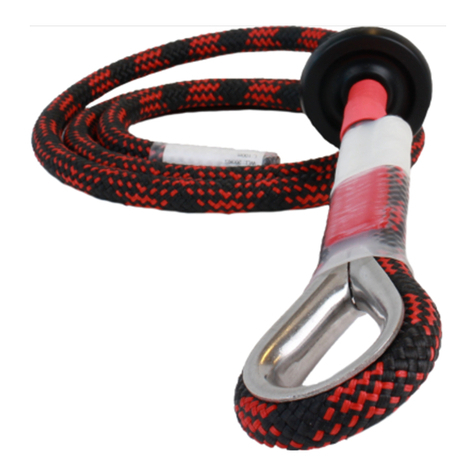
SKYLOTEC
SKYLOTEC ANCHOR ROPES Instructions for use

Besto
Besto Buoyancy Aid 50N Instructions for use

TEUFELBERGER
TEUFELBERGER NODUS Manufacturer's information and instructions for use

Troy Lee Designs
Troy Lee Designs Tbone Product owners manual
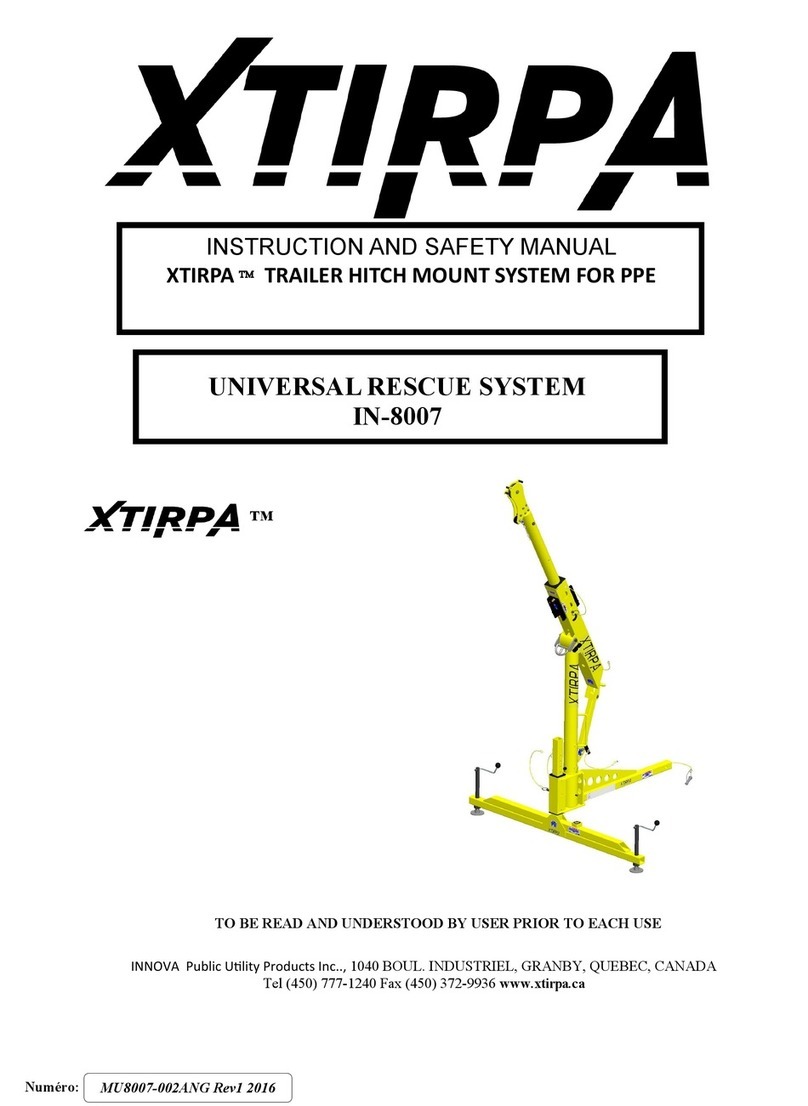
Innova
Innova Xtirpa Instruction and safety manual

bolle SAFETY
bolle SAFETY B810 quick start guide
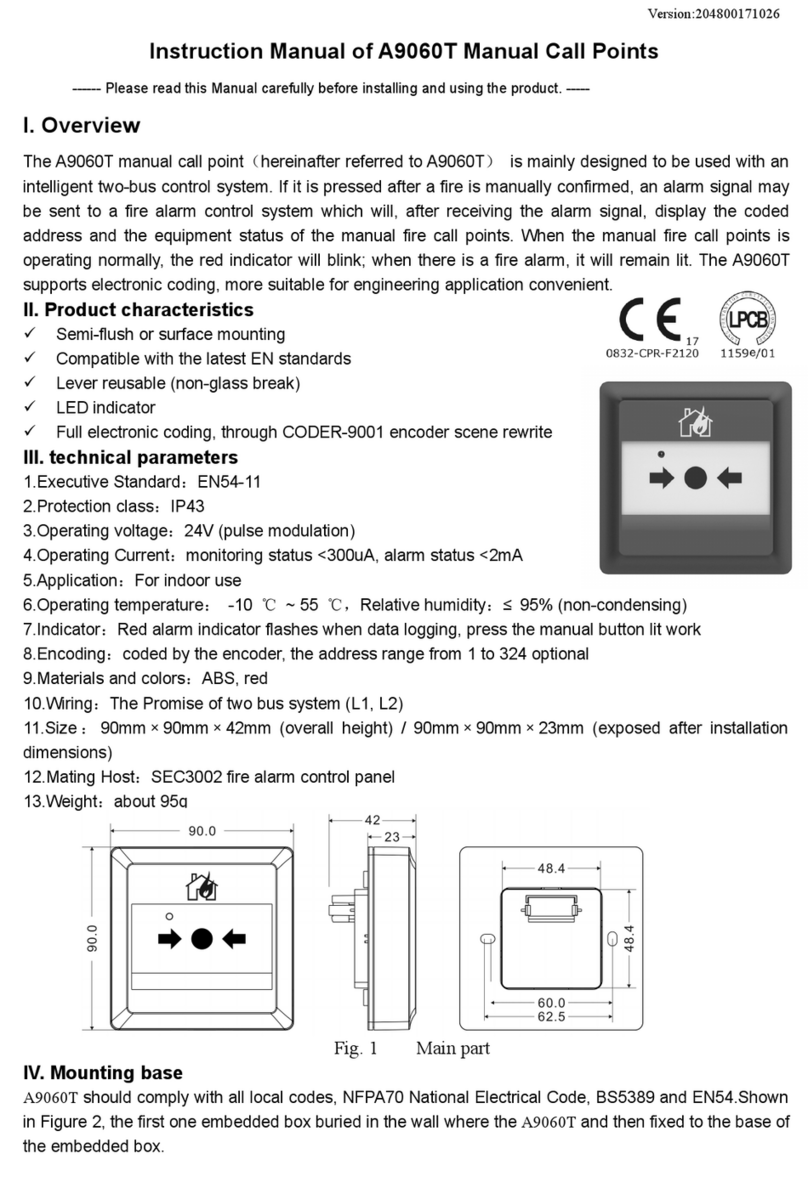
SHENZHEN FANHAI SANJIANG ELECTRONICS
SHENZHEN FANHAI SANJIANG ELECTRONICS A9060T instruction manual
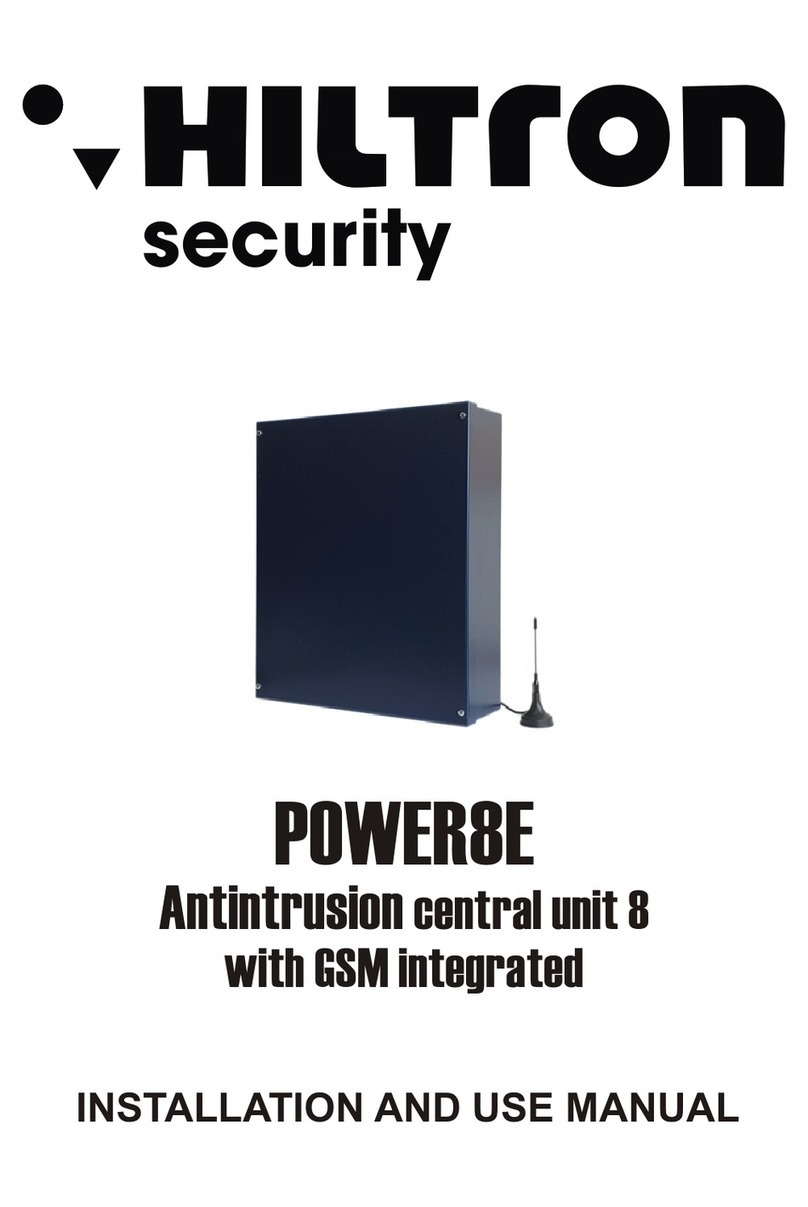
Hiltron security
Hiltron security POWER8E Installation and use manual

Salewa
Salewa MTN SPIKE user manual
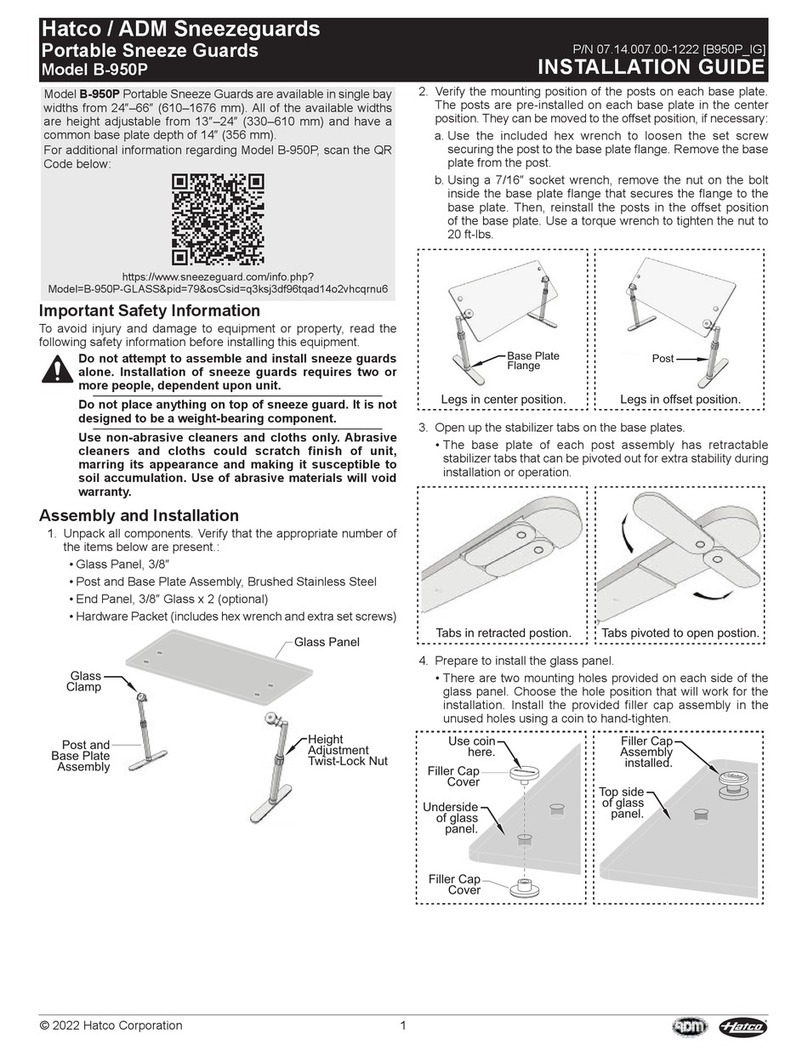
Hatco
Hatco B-950P installation guide
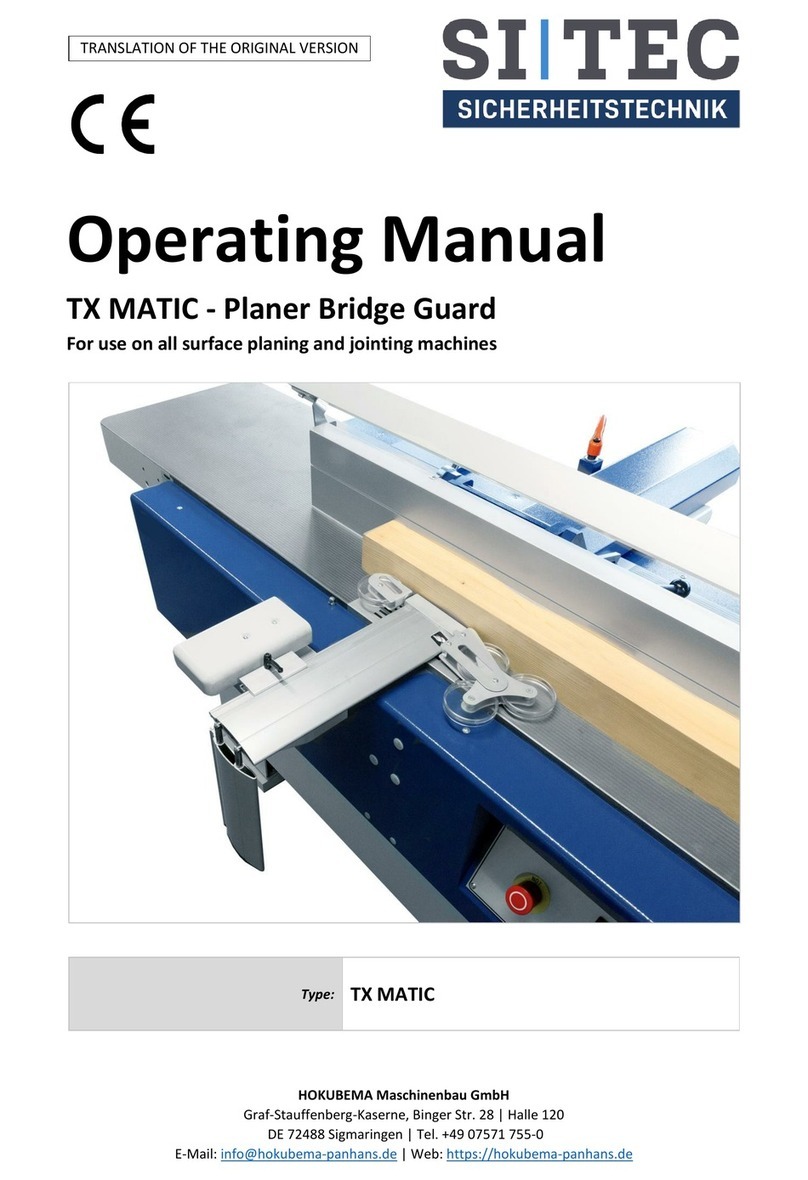
Sitec
Sitec TX MATIC operating manual




